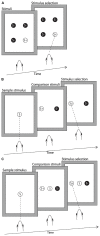Concept learning and the use of three common psychophysical paradigms in the archerfish (Toxotes chatareus)
- PMID: 24795572
- PMCID: PMC4006028
- DOI: 10.3389/fncir.2014.00039
Concept learning and the use of three common psychophysical paradigms in the archerfish (Toxotes chatareus)
Abstract
Archerfish are well known for their specialized hunting technique of spitting water at prey located above the water line. This unique ability has made them a popular focus of study as researchers try to understand the mechanisms involved in targeting and spitting. In more recent years, archerfish have also become an increasingly popular model for studying visual discrimination and learning in general. Until now, only the alternative forced-choice (AFC) task has been used with archerfish, however, they may be capable of learning other classical discrimination tasks. As well as providing alternative, and potentially more efficient, means for testing their visual capabilities, these other tasks may also provide deeper insight into the extent to which an organism with no cortex can grasp the concepts underlying these tasks. In this paper, we consider both the matched-to-sample (MTS) and the odd-one-out (OOO) tasks as they require the subject to learn relatively sophisticated concepts rather than a straight, stimulus-reward relationship, of the kind underlying AFC tasks. A variety of line drawings displayed on a monitor were used as stimuli. We first determined if archerfish could complete the MTS and OOO test and then evaluated their ability to be retrained to new stimuli using a 4-AFC test. We found that archerfish were unable to learn the MTS and had only a limited capacity for learning the OOO task. We conclude that the MTS and OOO are impractical as paradigms for behavioral experiments with archerfish. However, the archerfish could rapidly learn to complete an AFC test and select the conditioned stimulus with a high degree of accuracy when faced with four stimuli, making this a powerful test for behavioral studies testing visual discrimination. In addition, the fish were able to learn the concept of oddity under particular training circumstances. This paper adds to the growing evidence that animals without a cortex are capable of learning some higher order concepts.
Keywords: alternative forced-choice; behavior; matched-to-sample; odd-one-out; visual discrimination.
Figures







Similar articles
-
Discrimination of human faces by archerfish (Toxotes chatareus).Sci Rep. 2016 Jun 7;6:27523. doi: 10.1038/srep27523. Sci Rep. 2016. PMID: 27272551 Free PMC article.
-
Same/Different Abstract Concept Learning by Archerfish (Toxotes chatareus).PLoS One. 2015 Nov 23;10(11):e0143401. doi: 10.1371/journal.pone.0143401. eCollection 2015. PLoS One. 2015. PMID: 26599071 Free PMC article.
-
Archerfish vision: Visual challenges faced by a predator with a unique hunting technique.Semin Cell Dev Biol. 2020 Oct;106:53-60. doi: 10.1016/j.semcdb.2020.05.017. Epub 2020 Jun 7. Semin Cell Dev Biol. 2020. PMID: 32522409 Review.
-
Visual search in hunting archerfish shares all hallmarks of human performance.J Exp Biol. 2013 Aug 15;216(Pt 16):3096-103. doi: 10.1242/jeb.087734. Epub 2013 Apr 25. J Exp Biol. 2013. PMID: 23619420
-
Hunting in archerfish - an ecological perspective on a remarkable combination of skills.J Exp Biol. 2018 Dec 10;221(Pt 24):jeb159723. doi: 10.1242/jeb.159723. J Exp Biol. 2018. PMID: 30530768 Review.
Cited by
-
Discrimination of human faces by archerfish (Toxotes chatareus).Sci Rep. 2016 Jun 7;6:27523. doi: 10.1038/srep27523. Sci Rep. 2016. PMID: 27272551 Free PMC article.
-
The archerfish uses motor adaptation in shooting to correct for changing physical conditions.Elife. 2024 Jun 3;12:RP92909. doi: 10.7554/eLife.92909. Elife. 2024. PMID: 38829209 Free PMC article.
-
Same or different? Abstract relational concept use in juvenile bamboo sharks and Malawi cichlids.Curr Zool. 2018 Jul 14;67(3):279-292. doi: 10.1093/cz/zoy059. eCollection 2021 Jun. Curr Zool. 2018. PMID: 34616920 Free PMC article.
-
Super-resolution reconstruction in ultrahigh-field MRI.Biophys Rep (N Y). 2023 Mar 29;3(2):100107. doi: 10.1016/j.bpr.2023.100107. eCollection 2023 Jun 14. Biophys Rep (N Y). 2023. PMID: 37114210 Free PMC article.
-
The Transition to Minimal Consciousness through the Evolution of Associative Learning.Front Psychol. 2016 Dec 22;7:1954. doi: 10.3389/fpsyg.2016.01954. eCollection 2016. Front Psychol. 2016. PMID: 28066282 Free PMC article.
References
MeSH terms
LinkOut - more resources
Full Text Sources
Other Literature Sources
Research Materials

